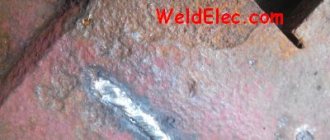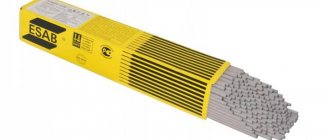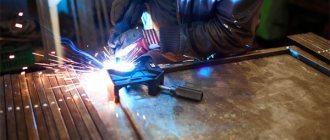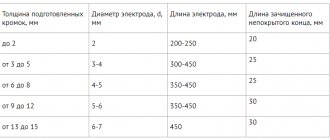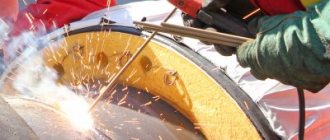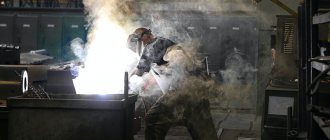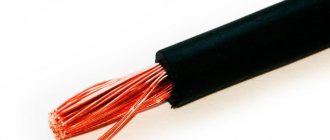Stainless steel is one of the most popular materials due to its complete inertness with respect to moisture. The material is not subject to corrosion, which significantly expands its scope of application. In addition to this, there are excellent aesthetic characteristics that do not require additional decoration or coloring. The disadvantage of the metal is its poor weldability. Two workpieces can only be joined using special electrodes for welding stainless steel.
In this case, it is necessary to take into account a number of features that appear in the process of welding two stainless steel workpieces:
- The material has lower thermal conductivity compared to other grades of steel. For this reason, you need to heat the welding zone longer or resort to another technique by increasing the current.
- Between thick stainless steel workpieces, the gap should be larger than in the case of joining metals of other brands. This way it is possible to reduce to a minimum the number of cracks that appear as a result of thermal effects.
- Stainless steel has a strong resistance coefficient. During welding, its surface becomes very hot. Therefore, only special electrodes should be used.
What are the features of stainless steel electrodes?
To weld stainless steel (the correct name is corrosion-resistant steel), special stainless steel piece electrodes are used. These electrodes are manufactured for use with direct and/or alternating current. Electrodes for direct current are more common since the welding process proceeds more smoothly and the quality of the seam is higher.
The peculiarity of the process is that stainless steel has a low thermal conductivity coefficient, that is, it is easy to overheat and the metal begins to spread. It also has a high linear expansion coefficient. This means that during the welding process the metal expands greatly, and then when the seam crystallizes, the metal shrinks and often a defect such as a “sink” appears - lack of penetration.
Another harmful consequence of a high linear expansion coefficient is that structures are severely deformed under the influence of welding stresses.
Therefore, when choosing electrodes, you should try to comply with the following conditions:
- Use a diameter of 1.5 – 2.6 mm;
- Use electrodes with a core composition similar to the base metal;
- To reduce the risk of lack of fusion, it is necessary to provide a wider gap - larger than the diameter of the electrode.
Therefore, it is best to weld such steel as quickly as possible, using the minimum current value. This can be accomplished using smaller diameter electrodes. These measures will help reduce overheating of the metal, as well as avoid severe welding deformations.
Why is it important to use special electrodes for welding stainless steel?
This is because the vast majority of these steels are high alloy steels. Welding of which is complicated by multiple factors such as:
- High carbon content in the weld.
- High requirements for protecting the weld pool and arc from air, which otherwise leads to a large number of defects.
- Low thermal conductivity which often leads to overheating of the metal during the welding process and the formation of defects in the form of burns.
If we take, say, electrodes for ferrous steel (unalloyed) and try to weld, then the weld will turn out, but it will have many unacceptable defects, roughly speaking, we will get a defect.
In addition, the weld metal will be susceptible to corrosion since the metal of the electrodes did not have the necessary alloying elements.
Also, they used for stainless steels must be specially designed for welding this particular group of steel and must be similar in chemical composition. If this condition is not met, the weld will withstand less stress than the base metal and will be the weakest area of the part.
Another important factor is that the welding area and the edges of the parts must be very well cleaned, and preferably degreased. As already mentioned, during assembly you need to maintain a slightly increased gap.
Useful article - How not to make a mistake in choosing and correctly decipher the designations of electrodes for welding metals
Properties of stainless steel
Stainless steel has a low heat conductivity coefficient. Therefore, during welding work, heating of the local area is required to form a uniform seam. To achieve the required technical characteristics, it is necessary to install high currents on the welding machine.
To prevent overheating or scale, it is necessary to make a larger gap when joining parts than in the case of welding steel workpieces. The seam absorbs significant deformation loads during the cooling process, due to which the main structural elements maintain their geometry.
A welding electrode with a specially selected composition for specific alloys avoids overheating of the main rod. That is, the resistance of the metals is approximately the same, due to which there is no overheating process.
What electrodes should be used to cook stainless steel using alternating and direct current?
For welding corrosion-resistant steels with alternating current, electrodes containing rutile in their coating are mostly used. These can be electrodes with pure rutile coating, rutile-cellulose, rutile-carbonate and others. Rutile, which is part of the coating, ensures easy ignition and stable combustion of the welding arc.
When welding with alternating current, there is no such thing as polarity (forward, reverse) which is inherent only in welding with direct current.
Even with additional components in the coating composition, welding with alternating current is of lower quality and has a number of limitations compared to direct current, and therefore is used less frequently.
Reviews
Denis, Donetsk. I only cook stainless steel TsL-11. It turns out best.
Artem, Voronezh. I only use OZL-6/8. In my opinion, the most reliable of the budget consumables on the Russian market.
Victor, Kursk. For high-alloy steel I use only OK 61.30 ESAB. Rutile coating behaves much better than the main one. And the seam will be stronger.
Source
Stainless steel electrodes for alternating current
Let's consider several main brands used for welding on stainless steel with alternating current. They can also be used for DC welding.
TsT 50
This grade is used for welding stainless steel, which is extremely common both in industry and in everyday life: 08x18n10t, 12x18n10t, 12x18n9t and others. They are used when there are no special requirements for the corrosion resistance of the connection. Available in diameters from 3 mm to 5 mm. Their coating is rutile-basic. They usually work on alternating current, but can also be used on direct current with reverse polarity, in all spatial positions except for the vertical position from top to bottom.
OZL 14
These electrodes, just like their predecessors, are used on austenitic class stainless steel (all using the same 12Х18Н10Т, 12Х18Н9). They are also designed for conditions that do not require strict parameters for intergranular corrosion. Welding is possible in all spatial positions, on alternating / direct current. They are produced in diameters of 3 and 4 millimeters. They have a rutile coating.
Important: when using rutile-coated electrodes, severe slagging of the welding seam is possible. This is a note for novice welders, since it is very difficult to distinguish molten metal from slag in the weld pool.
OZL-310
These electrodes are used for welding and surfacing of heat-resistant chromium-nickel alloys, high-alloy steels X45Х25Н20С2 and welding of heat-resistant ferritic-pearlitic steels. Coatings - rutile - carbonate. They are produced in diameters of 3-4 millimeters and are used for welding on alternating current (can be used on direct current). They have excellent welding and technological properties because they contain 20-22 percent nickel. You can cook in all spatial positions with the exception of vertical from top to bottom.
Useful article - How to choose the right welding cable for an inverter machine and not lose money.
Features of stainless steel welding
Welding stainless steel elements requires knowledge of a number of features regarding the correct implementation of this work:
- The connection of workpieces up to 1.5 mm thick is carried out using technology in protective inert gases, which involves the use of tungsten non-consumable electrodes. In this case, welding can be performed manually or in automatic or semi-automatic mode.
- When working with workpieces with a thickness of 1.5 to 3 mm, short-arc welding is used.
- To weld workpieces with a thickness of more than 3 mm, the electric arc welding method is used, which involves jet transfer of metal from the electrode.
I would like to say a few words about argon welding, which has a number of important nuances. During welding, care must be taken to ensure that tungsten does not accidentally enter the weld pool. Otherwise, this will negatively affect the strength properties of the weld. This can be avoided if ignition is carried out in a non-contact manner, or by first lighting the arc on a graphite or carbon plate, and then continuing to work on stainless steel parts prepared for connection.
Electrodes for DC welding
Now let's look at the electrodes used when welding stainless steel with direct current. Welding with direct current is more stable. They contain a minimum amount of elements for ionization in the coating. They are a little more difficult to light than those used with alternating current.
The DC welding process is performed by connecting the device to reverse polarity. Reverse polarity is a connection of the device when the plus is connected to the holder, and the ground is connected to the part.
Let's consider several main brands, such as OK 61-35 and 61-30 manufactured by Esab, electrodes EA 400/10U, TsT-15, TsL-11, etc. Next, we will dwell in more detail on some of those listed here.
Popular electrodes for welding stainless steel (steel 12x18n10t)
Most often in everyday life we have to use electrodes for welding stainless steel grade - 12x18n10t, called “medical steel”. This is chromium-nickel steel of the austenitic class (it is highly alloyed, so the content of alloying elements exceeds 10%). Let's look at the most commonly used electrodes for welding this steel.
OK 61-35
These electrodes are used for welding steel 12x18n10t mainly for critical welds for which there are high requirements for the resistance of the weld and the product as a whole to intergranular corrosion. They are used for products that operate in the temperature zone from – 196 to 400 degrees, which allows them to be used even for cryogenic installations. They have basic coverage. They have a fairly high cost.
EA 400 10u
Just like the previous electrodes, they are used for welding high-alloy steel 12x18n10t, but when the operating temperature of the product does not exceed 350 degrees. Unlike the previous grade, EA 400/10u is used in cases where high requirements for intergranular corrosion are not imposed. They can be cooked in all spatial positions, from top to bottom. Coverage is basic. Their cost is much lower, and they are often used for domestic purposes. Available in diameters from 2 to 5 mm.
EA 395/9
This grade is used for welding austenitic stainless steel, as well as for welding them with carbon steel. They have a basic coating and are used on direct current. The seam produced by these electrodes is of very high quality, smooth with fine flakes. Available in diameters from 3 to 4 mm.
TsL 11
These electrodes are used when the task is to weld a seam with high requirements for resistance to intergranular corrosion. These electrodes have a basic coating and welding with them is possible in all spatial positions. Products that are welded with these electrodes can be operated at temperatures up to 400 degrees. Like previous brands, their diameter ranges from 2 to 5 mm.
CT 15
These electrodes are used for welding the same chromium-nickel stainless steel 12x18n10t. Also X16N13B and similar steels operating at temperatures of 560-650 degrees and subjected to high pressure. Used in conditions where strict requirements for intergranular corrosion are imposed. Most often they are used in industry, since at home, as a rule, there are no such high temperatures. They have a basic coating; welding is possible in all spatial positions.
Useful article - Everything you need to know about gases used for welding from A to Z
Features of stainless steel
Unlike a number of other popular metals, stainless steel has a number of features that can appear when connecting elements from this metal. All this must be taken into account when starting to manufacture various structures and products from this material. Compared to many other types of steel, stainless steel has lower thermal conductivity. Because of this, you have to spend more time warming up the welding zone or use a higher current for work.
When welding elements of fairly large thickness made of stainless steel, the gap between them should be slightly larger than when connecting elements made of other types of steel. This is the only way to minimize the number of microcracks that may appear after welding.
When joining stainless steel elements by welding, the welding rods are heated to very high temperatures. This happens due to the fact that the metal has high resistance to welding processes. To reduce this manifestation, experts recommend using special electrodes designed for stainless steel for welding.
Electrodes for stainless steel - common markings
In this section, we will consider brands that are also often used both in production and at home for chromium-based stainless steel.
UONI-13/NZH
These electrodes are used for welding chromium steels such as 12x13 and similar, with a chromium content of 13 percent. They have basic coverage.
OZL 8
These electrodes are used for corrosion-resistant steels such as: 12Х18Н9Т, 12Х18Н10Т and the like in cases where there are no strict requirements for intergranular corrosion resistance. Their coating is basic; they can cook stainless steel in all positions (from top to bottom) on direct current.
TsL-25
These electrodes are used for welding heat-resistant stainless steels containing chromium and nickel, such as 10Х23Н18, 20Х23Н13 and similar ones operating up to 1000 degrees. They have basic coverage. There are a number of restrictions on welding with them, such as the width of the bead, which should not be more than 3 diameters of the electrode, as well as mandatory calcination before welding at a temperature of 350-370 degrees.
TsL-9
These electrodes are most often used for welding two-layer steel (the so-called bimetal). They weld alloy steel grades 08Х13, 12Х18Н9Т and the like. The weld seam will meet the high requirements for intergranular corrosion. The coating of these electrodes is basic. Available in diameters from 3 to 5 mm.
OZL-22
These welding electrodes are used for stainless steel made from low-carbon chromium-nickel steels. The coating of these electrodes is special. They can not be cooked in all spatial positions, but only in: lower, vertical, and limited in the ceiling. The diameter of these electrodes is available in 3 and 4 millimeters.
Useful tips
In order for welding of stainless steel parts to take place without any difficulties, during work you should take into account the recommendations from professionals:
- If during welding work the temperature rises to +500 degrees Celsius or higher, then it is quite possible that crystallization-type cracks will appear at the site of the future weld. This should not be allowed, otherwise the connection will be less strong and reliable.
- When welding stainless steel parts at temperatures from +350 to +500 degrees Celsius, the alloy becomes less ductile, and this can make the metal more brittle.
- To create a high-quality weld, stainless steel parts prepared for joining must be heated to a temperature of +1200 degrees, and then cooled naturally. They need to cool for at least 3 hours.
- The welding seam is as strong and reliable as possible when welding takes place in the shortest possible time. Prolonged heating of stainless steel products should be avoided. When using the layer-by-layer welding method, a new layer is applied only when the previous one has cooled to +100 degrees.
- Sometimes before applying the base layer you have to tack two blanks. In this case, you need to make sure that the gap between them is as small as possible. You should strive to ensure that the potholders are as long as possible.
Which is better AC or DC?
The answer to this question is quite simple - it is direct current. AC sources have a certain number of advantages, such as low power losses, but the quality of the welding seam with alternating current is lower. This is due to the fact that when welding with alternating current, the arc has zero voltage for a period of 3 times. In fact, it breaks off for a split second and flares up again.
To stabilize the arc, special components are added to the electronic coating that improve ionization. Also, with alternating current, polarity changes 120 times per second at an industrial frequency of 60 Hz, which in turn affects the instability of the welding process.
Let's talk a little about polarity. When using reverse polarity, maximum heating goes to the electrode, which in turn reduces the amount of heat introduced into the part, and this reduces deformation.
When using direct polarity, the situation is reversed; maximum heat is removed into the part, which can provide deeper penetration of the metal and is used for welding parts with large thicknesses. It is also used for TIG welding so as not to introduce additional overheating to the tungsten electrode.
When welding with alternating current, the polarity is straight for half a period, and then reversed, which in turn negatively affects the quality of welding.
Necessary Precautions
When choosing any welding technology, observe the following safety rules:
- Do not use faulty devices. The main units of equipment are checked before starting work. The wires must not be damaged. If necessary, the cables are replaced.
- Only new electrodes with intact coating are suitable for use. The use of cracked rods is unacceptable.
- The workplace is set up in advance. Flammable liquids and materials, as well as foreign objects that could hinder the process, are removed from the welding zone.
- When working, use a welding mask, a special suit, gloves, and tarpaulin boots. A dielectric mat is laid near the equipment, eliminating the possibility of electric shock to a person.
- The room is equipped with a powerful ventilation system.
- The work is carried out on a special table. It is not recommended to keep parts suspended.
- When using inert gas or oxygen, there should be no traces of oil on the welding table.
We recommend reading: How to cook stainless steel in an argon environment
What electrodes are used for welding stainless steel with ferrous metal (transition electrodes)
Let's consider the so-called transition electrodes; these are electrodes that are used to weld ferrous metal to stainless steel. Hence the name “transitional” - the transition from one steel to another. They are used both in industry and in everyday life, for example when welding a tank in a bathhouse.
Let's look at the main electrodes that are most often used.
OZL 6
These electrodes are intended for welding carbon and low-alloy steels of the pearlitic class (for example, steel 20, 09G2S) with steels of the austenitic class. They are also used for welding heat-resistant chromium-nickel steel (for example 20Х23Н18) which can operate at temperatures up to 1000 degrees. The coating of these electrodes is basic; welding is possible in the Lower, vertical and ceiling positions. Electrodes are produced with diameters from 2 to 5 mm. Before welding, mandatory calcination at a temperature of 300-335 degrees for one hour.
Ok 67.60
These electrodes manufactured by Esab OK have an acid-rutile coating. As a result, the arc lights up very well (this is due to the presence of rutile in the coating). They are used for welding chromium-nickel steels with black low-alloy low-carbon steels. You can cook with electrodes in all spatial positions except from top to bottom. Electrodes must be calcined before welding at temperatures up to 370 degrees for 2 hours.
Which welding technology is better to choose?
When deciding how to weld stainless steel to ferrous metal in a home workshop, welders prefer cheap methods. However, the most durable seam is obtained using expensive argon arc technology. Such equipment is rarely found in a home workshop. Purchasing the device is not advisable.
Inverters are cheaper. Stable operation and high strength of the resulting seam make this equipment preferable for home craftsmen.
Manual arc technology is only suitable for forming horizontal connections. When exposed to high temperatures, the steel melts and the weld pool moves.
What electrodes should be used to cook 1 mm stainless steel?
Welding stainless steel is not an easy process, especially when it comes to small thicknesses. Stainless steel is easy to overheat and burn through because it has a low thermal conductivity coefficient. Also, thin metal is very susceptible to deformation that occurs during the welding process.
To weld such thin stainless steel, it will be necessary to use electrodes with a rutile acid coating. One of the brands that can be used is OK 63.20. These electrodes are suitable if the operating temperature of the part is up to 350 degrees Celsius.
Another brand that you can consider is OK 63.34. These electrodes are similar in properties to the previous brand; they can be used for welding from top to bottom. Using this method reduces the temperature and, accordingly, the risk of burning through thin metal.
It is also worth considering a brand of electrodes such as OK 61.20 from ESAB. They have a rutile acid coating and are designed for welding thin-walled parts, provided that operation is up to 400 degrees.
Where and why are dissimilar steels and alloys used?
In modern industry, structures made from such materials are widely used. They are necessary where their individual parts operate under different conditions - under different alternating loads, temperature levels and aggressiveness of environments, abrasive wear, pressure, etc. In a number of such areas:
- rocket science;
- shipbuilding;
- energy (nuclear, thermal);
- radio electronics;
- mechanical engineering;
- cryogenic plants, etc.
Constructions of this type are called combined. They provide the necessary technical and technological characteristics of the equipment, and in a wide range of cases allow making its production more economical.
General principles for choosing electrodes
The choice of welding electrodes must be made according to the material of the part (the main material from which the parts are made). The easiest way is to type on the Internet (but it’s better, of course, to look in GOST or a steel brand) the mechanical characteristics of the material we need. We are interested in such characteristics as the yield strength - σт and temporary resistance σв.
We get the values and go to the Internet, GOST or the catalog of electrodes and compare the values. The base metal values should be equal to or slightly less than the electrode values. And of course, as already mentioned, the composition of the metal in the electrodes must correspond to or be close to the base metal.
Basic technologies and varieties
In addition to the basic requirements for electrodes, there are several methods that are most often used for welding sheet or other types of stainless steel. The quality of welding is influenced by many factors that affect the further use of the material and the possibility of processing by various methods. Therefore, everyone who plans to use stainless steel should know the main features of steel and its main differences from carbon steel.
Stainless steel can be welded using various methods, but the most popular and used for medium-density material remains gas welding. For this method, a tungsten electrode with minimal melting ability is used. This method can be used to weld stainless steel for various purposes. For example, creating a pipeline from steel or various parts where stainless steel is applicable.
Depending on the technical equipment and requirements, electrode welding can be performed using manual, automatic and semi-automatic methods.
Consumable electrodes can also be used. They are additionally coated with special substances or wire with a high degree of alloying is used. For this variety, separate welding methods are selected:
- Pulse-arc;
- Short-arc;
- Jet arc;
- Plasma
They all differ in certain properties. For example, the first option is used for thin surfaces - the calculation is per tenth of a millimeter. Arc, on the contrary, is used for medium sheets, up to three millimeters thick. Plasma, in turn, is a universal method of welding stainless steel.
Methods
The most popular method for welding stainless steel and ferrous metals is electric welding. This method has earned recognition and popularity due to its low cost and small number of auxiliary manipulations. Unfortunately, when choosing electric welding, you often have to sacrifice the quality of the connections. The reason for this is the different viscosity indicators of stainless steel and ferrous metals. At the arcing temperature, steel can spread, while ferrous metal remains quite viscous.
High fluidity limits the welder's actions. It is almost impossible to apply a vertical or ceiling seam. When working with dissimilar metals, you have to use transition electrodes adapted for stainless steel and ferrous metal. The electrodes themselves, or rather their rods, are made of stainless steel.
Gas welding is characterized by the presence of filler material, presented in the form of stainless steel wire. When gas welding, steel is less fluid, so this method has some advantages compared to arc welding. A special flux allows you to increase the efficiency of melting ferrous metal. The disadvantage of gas welding is increased safety requirements, as well as a large amount of preparatory work.
Experts call argon arc welding the best way to weld stainless steel and ferrous metal. There is no need to use coated filler wire as argon does a great job of protecting the weld pool. With all the advantages of the listed methods, it should be noted that welding stainless steel and metal does not always pay off, since the financial costs are prohibitively high.
The determining factor in choosing one of the listed welding methods will be the goal and the existing conditions.
- When carrying out minor household repairs at home, the most optimal solution is electric arc welding with stainless steel electrodes. Naturally, high mechanical loads on the structure are excluded.
- Gas welding will provide a more reliable connection. But it is available only in specialized workshops. A private master is unlikely to agree to purchase expensive equipment that also takes up a lot of space. In industry and production, semi-automatic TIG machines are used for argon arc welding. The quality of the resulting seams is high, but the process itself is associated with material costs.
